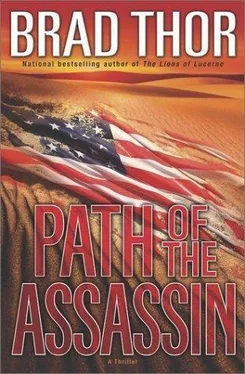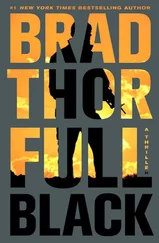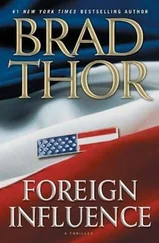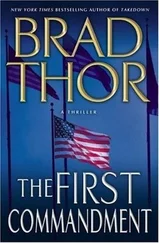“Then you come up with a way to get us in without him knowing. Until I see my people, I’m not going anywhere else with you.”
Scot could see that she was serious. He thought for a moment and then pulled Detective Gasteire aside. Fifteen minutes later, Harvath and Meg had discreetly climbed into an ambulance via a lower-level loading dock and were on their way. Gasteire met them at one of the seldom-used alley entrances of Northwestern Hospital’s main facility. He provided them with surgical scrubs, long white lab coats, paper hats, and booties. Harvath was happy to get out of his wet clothes. He fastened his belt around his waist so he could continue to carry his gun and placed the rest of his belongings in the deep pockets of the lab coat. Everything else was left in the waiting ambulance.
Gasteire escorted them from room to room. Several of Meg’s staff were already close to being discharged and sent home. She spent time with two men who would probably be staying in the hospital through the week and promised their families that they would receive the absolute best care. Harvath was moved by Meg’s loyalty to the people that worked for her.
The last patient they visited was the most distressing and the one Meg was most concerned about, her assistant, Judy. Meg didn’t want to go into the room alone and so asked Scot to come in with her. Burn Unit rules were some of the strictest around and with good reason, few patients were as prone to infection and the deadly complications it could bring.
Harvath and Meg scrubbed as if they were going into surgery and donned new paper caps, booties, and disposable paper gowns. They were also required to wear gloves and masks-the biggest risk being an infection transmitted via the respiratory system. Detective Gasteire sat outside their door holding Harvath’s SIG and other personal belongings.
At the sight of her good friend, Meg Cassidy began to cry. Because of her charred lungs, Judy was enclosed in a plastic oxygen tent and on a ventilator. The area where the flesh of her chest and arms had been burned away was covered in some places with a thick white salve and in others with wet-to-dry bandages soaked in a special saline solution. Morphine for pain and antibiotics to fight infection were intermingled with her IV fluid. Judy’s eyes were closed, and it was hard for Meg to tell if she was sleeping or not. Harvath, though, knew that the woman was on so much pain medication that she was in a state much deeper than sleep.
All Meg wanted to do was take her friend’s hand and tell her everything was going to be okay, but that was impossible. Nothing was allowed to breach the patient’s oxygen tent. Though they were only inches apart, the inability for them to physically connect made Meg feel as if a chasm hundreds of miles wide lay between them.
She pulled up a chair next to the bed and let the tears roll down her face. She had neither the strength nor the desire to wipe them away. Judy’s chest rose and fell to the mechanical rhythm of the ventilator.
This is all my fault, Meg thought to herself. All my fault.
She remembered Judy’s face floating before her during the hijacking. She remembered wanting to believe that Judy, who kept her crazy life in order and doted on her like a daughter, somehow was her guardian angel. If it hadn’t been for her lousy coffee, I would be lying in that bed right now, or worse.
Meg leaned in as close to the oxygen tent as she dared and whispered, “You really are my guardian angel. I love you so much, Judy. Everything is going to be okay. I promise.”
When Meg Cassidy stood up and crossed the room to leave, she locked eyes with Harvath who had been respectfully standing against the far wall. “I don’t care what I have to do, or where I have to go. That animal has to be stopped. I don’t want him harming another human being.”
Harvath waited before opening the door. “So you’re in?”
“You’re goddamn right I’m in. And you tell the president he can keep his reward money.”
“Giant Killer, Giant Killer. This is Stork One requesting clearance,” said the pilot of the luxuriously appointed Falcon 900 passenger jet. The air traffic control moniker was intimidating to say the least, but that was exactly its purpose.
The airspace over the CIA’s highly secretive training facility known as Harvey Point, or more simply the Point, was restricted. The Washington Sectional Chart, which every pilot flying in and around the area would have aboard, specifically stated that clearance to pass through Restricted Area R-5301 could only be obtained by contacting “GIANT KILLER” on the indicated frequency. Failure to do so would result in the scrambling of a contingent of the most-advanced tactical fighter aircraft in the world, Lockheed Martin F-22s, quietly stationed with the Fourth Fighter Wing at nearby Seymour Johnson Air Force Base.
Interestingly, there was no depiction at all of a Harvey Point runway on the sectional chart. This was highly unusual as far as sectional charts were concerned because military airfields were never omitted. Even the CIA’s airstrip at Camp Peary, Virginia, was clearly depicted and labeled.
Stork One was immediately cleared and given instructions on how to land.
The Point itself was just that-a stubby finger of land that curled out into the murky water where North Carolina’s Perquimans River met the Albemarle Sound. Thick-trunked cypress trees overgrown with heavy Spanish moss stood silent vigil over the sixteen hundred acres of poisonous-snake-infested swamp on which the CIA’s facility sat. Locals claimed that the area had once been ruled by Blackbeard the pirate, who had buried his treasure somewhere in the vicinity. It was all the locals could publicly claim, because it was the only thing they were really sure of.
Nine miles southwest of the sleepy town of Hertford, the road abruptly ended at a sign that read, “Harvey Point Defense Testing Activity.” Officially, it was known as a remote Pentagon post, but ever since its inception in 1961, just weeks after the Bay of Pigs fiasco, area residents believed it to be some sort of base for the CIA. Explosions from the Point could be heard and felt for miles around as windows shook and walls sometimes cracked. Strange-looking helicopters often swept in low from the skies overhead, while blacked out transports conveyed unknown passengers quickly through town in the middle of the night. All sorts of old cars, buses, SUVs, and limousines were seen entering on flatbed trucks, only to be carried out later either riddled with bullet holes or burnt to nothing more than charred hulks, or both. The locals had, indeed, pegged Harvey Point correctly, but they didn’t know the half of what went on there.
The Point was where the CIA’s hard-core paramilitary training took place. Personnel were schooled in explosives, paramilitary combat, and other clandestine and unconventional warfare techniques. While the “Farm” at Camp Peary was where CIA personnel earned their stripes and learned their tradecraft, the Point was where a chosen few received a Ph.D. in serious ass-kicking.
The personnel invited to the Point weren’t only limited to American CIA operatives. In the past fifteen years, the CIA had provided counterterrorism training to several American Special Operations groups, as well as foreign intelligence officers from more than fifty countries, including South Korea, Japan, France, Germany, Greece, and Israel.
As the Falcon 900 jet banked and came in over the water for its landing, Harvath watched Harvey Point’s runway magically materialize out of the dense cover of foliage. He knew it was only a trick of the landscape, but an uncomfortable feeling swept over him, nonetheless. Nothing was ever what it appeared to be with the CIA, and Harvath wasn’t looking forward to being a guest on their turf.
Читать дальше












